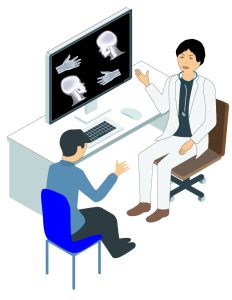Image diagnosis(Ultrasound examination, RI examination, SPECT, PET)
- HOME
- Cancer(Detailed examination)
- Image diagnosis(Ultrasound examination, RI examination, SPECT, PET)
- DWIBS, a cancer examination in the whole body using high-performance MRI. What is the difference from PET-CT scan?
DWIBS, a cancer examination in the whole body using high-performance MRI. What is the difference from PET-CT scan?
23.10.16
What is MRI and what is DWIBS using MRI?
MRI (magnetic resonance imaging) examinations generate a powerful magnetic field to capture a cross-sectional image of conditions inside the body. As it is useful for examination of the head and lower abdomen, MRI is also used for complete health checkup of human brain. DWIBS (Diffusion-weighted Whole body Imaging with Background body signal) is a method to identify all cancerous formations in the whole body using high-performance MRI to detect cancer and metastases in a wide area of the body, developed in 2004 by Japanese doctors.
What is the difference from PET-CT scan?
PET-CT is known as an examination to detect cancer throughout the body in the same session, but how is DWIBS different from PET-CT?
PET-CT detects cancer by using a camera to capture radiation emitted from test drug that have accumulated on the cancer, by injecting test drug into the body that reacts to sugar and emits minute amounts of radiation, utilizing the property that malignant tumors such as cancer metabolize sugar in greater quantities than normal cells. It takes about 3 hours including the injection of the test drug and the waiting time after the test.
DWIBS visualizes cancer by applying a magnetic field tuned to detect the movement of water between cells, utilizing the property of the higher density of cancer cells compared to normal cells.
DWIBS does not use drugs used in PET-CT and does not expose the patient to radiation. There are no dietary restrictions before the test, and diabetic patients, who is not fit to be tested with PET-CT, can also be tested. The test takes about 30 minutes, which is shorter than PET-CT. On the other hand, because the test is performed under a strong magnetic field, a patient with metals in their bodies cannot be tested.

Optimal testing for each individual patient
In addition, each test is not always suitable for all types of cancer. DWIBS is not good at detecting lesions around the lungs and heart, and there is no general consensus that one test is better than the other. Therefore, the most appropriate test will be chosen considering the medical condition of each patient. In any tests, it is normal for non-cancerous lesions such as inflammation to be detected, and not all lesions detected are cancerous, but those lesions that are detected will be closely examined again.
DWIBS may detect not only cancer, but also precancerous lesions (medical conditions before cancer) and non-cancerous benign diseases ( disease affecting pine, liver, kidney, pancreas, uterus, ovaries, prostate, etc.).
Please contact EAJ if you are interested in taking the DWIBS test, if you would like to know which test should be better in your case with DWIBS or PET, or if you would like to add the DWIBS test to your complete health checkup.
